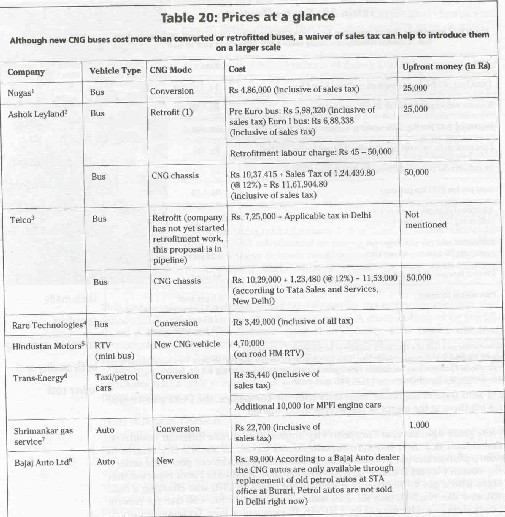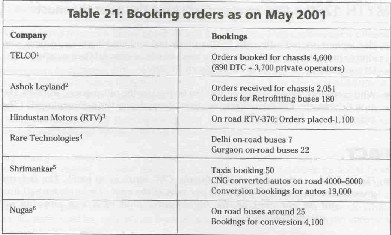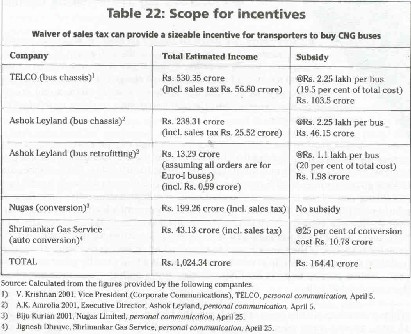Myth 11: CNG buses are much more expensive than diesel buses
Union
minister of petroleum and natural gas states that dependence on a single
fuel for the public transport system is not desirable, he said the higher
initial and subsequent maintenance cost of CNG vehicles, and substantially
higher prices of CNG compared to diesel has also to be considered (Hindustan
Times, July 26, 2001).
Fact
While capital
costs compared to diesel will go up in case of CNG, operational costs
will go down because of the lower fuel cost of CNG as compared to petrol
or diesel.
The maintenance costs of CNG vehicles are lower. The use of CNG extends
engine life, primarily because it is a gaseous fuel.
The cost of CNG conversion can be recovered in just about three years.
It is important to include health costs while estimating
cost effectiveness of the CNG strategy. A Swedish study comparing CNG
trucks with diesel trucks running on 10 ppm (0.001 per cent) sulphur diesel
(the best diesel in the world) with a CRT found that when public health
and environmental costs were included, the costs of running a CNG truck
was much lower.
This is just another manifestation of the several vested interests which
are resistant to meeting the deadline and the inaction of the government.
The high cost of CNG buses is a major reason for the current opposition
against it. The biggest opposition today is coming from transporters,
that is, bus, taxi and auto owners. Since these people constitute a major
vote bank, it is feared politicians will continue to pander to their opposition
because they see their political interest in doing so. Given the fact
that auto drivers have been asked to switch over to electronic meters
and a large number of transporters were allowed to bring in diesel buses
over the last two years despite the July 28 court order, they are all
arguing that conversion to CNG is yet another expense for them. These
people should be helped to move over to CNG through subsidies.
Even in public finance, a one-time subsidy is considered to be acceptable.
Subsidies, when given on a recurring cost like the price of fuel, are
always bad because they lead to a regular charge in government budgets.
A one-time subsidy is acceptable especially if it helps to offset the
recurring cost that the public bears for its health.
Health
costs of air pollution
According
to studies carried out by the World Bank and the Centre for Science and
Environment, the health costs of particulate pollution in Delhi were around
Rs. 1,000 crore in the early 1990s (see table 16: Health costs of particulate
pollution in Delhi).
A Swedish study comparing CNG trucks with diesel trucks run on 10 ppm
or 0.001 per cent sulphur diesel (the best diesel in the world) with a
CRT found that when public health and environmental costs were included,
the costs of running a CNG truck was much lower. The societal costs of
running a diesel truck even with a CRT were very high (see table 17: Cost
of alternatives).
Unfortunately, in India, even the full economic benefits of converting
to CNG have not been fully quantified. While capital costs compared to
diesel will go up, operational costs
will go down because of the lower fuel cost of CNG as compared to petrol
or diesel. In addition, the maintenance costs may also go down. The use
of CNG extends engine life, primarily because it is a gaseous fuel. As
a dry gas, it does not wash the cylinder walls, thereby lowering the amount
of lubrication. CNG engines are also less likely to contaminate engine
oil, extending the time between oil changes and extending engine life
by not weakening the lubricating abilities of the motor oil. CNG is less
prone to causing carbon deposits in the engine. The benefits from reduced
maintenance costs and extending of vehicle lifetime have not been quantified
in India.
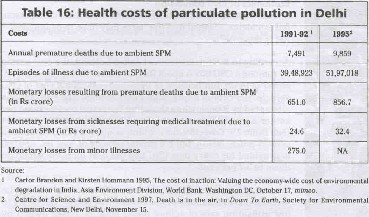
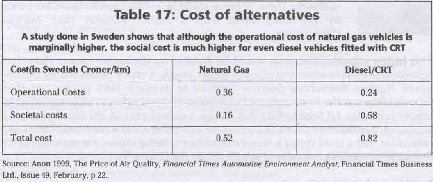
A subsidy on capital can bring down the increase in the cost of running a CNG bus — as compared to a diesel bus — from 6-12 per cent to 3-7 per cent per km.
Economics
of CNG conversion
In
a newspaper report, Delhi Transport Corporation chairperson, Rakesh Mehta,
claimed that the “fares may have to be doubled”81 But is this
true?
According to R Ramakrishnan of Ashok Leyland, the cost saving by running
a CNG bus is about Rs. 0.79 per kilometre (see table 18: Matter of thrift).
But because of the additional capital cost of CNG vehicle, the capital
depreciation cost is high. The calculations attempted by Ramakrishna show
that the actual cost increase per km for a new CNG bus over a diesel bus
would be 6-12 per cent (see table 19: Cost-effective), which is quite
a small amount to protect public health. But if a capital subsidy of,
say, Rs. 1,50,000 is provided for every new CNG bus the cost increase
would go down to 3-7 per cent.
According to another study, the cost of CNG conversion can be recovered
in 37.8 months or just about three years.82 But owing to low utilisation
rate of school buses (that is, buses owned by schools), CNG retrofitment
or buying a new CNG bus is a costlier option for them. Schools could be
encouraged to buy CNG buses by providing them with a higher subsidy than
normal transporters.
This higher subsidy to schools would be justified by the higher cancer
risks that schoolchildren face when travelling in diesel buses. A study
published by the US-based Natural Resources Defence Council in January
2001 points out that schoolchildren suffer from sustained exposures to
diesel exhaust while travelling in school buses for 1-2 hours every day
during a school year of 180-200 days over a schooling period of 10 years
(a normal school-going child’s routine). The study concludes that
a child riding a diesel school bus is being exposed to as much as 46 times
the cancer risk considered significant by the USEPA.83
Total
cost of conversion
The
Delhi government has already lost a major opportunity to get prices reduced
for DTC and the private transporters. The Delhi government keeps harping
on the fact that such a big effort to convert to CNG has not been made
elsewhere. But it did not try to turn this to its advantage. The government
could have easily pooled all the orders of the DTC and the private transporters
and then made the companies compete, thus, ensuring both quality and lower
cost. But by letting the one-two bus and auto owners negotiate separately
with the companies, the Delhi government has left them at the mercy of
the wolves in the market.
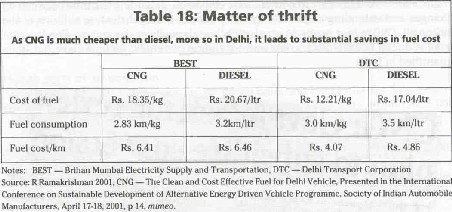
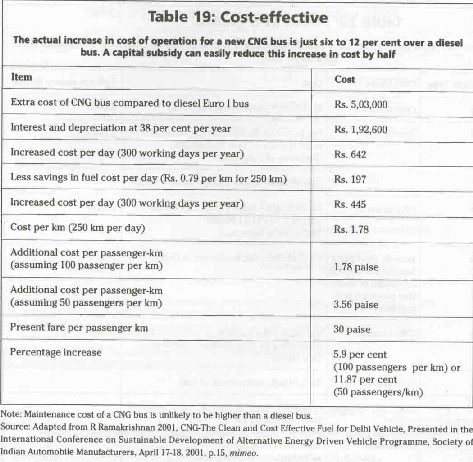
A
few years ago, several European city authorities, across different countries,
pooled their orders to buy zero-emission buses for use in historic city
centres to avoid pollution and got a big discount. If cities across nations
can pool their orders, why couldn’t we do it in one city? On April
8, 2001, Hindustan Times reported that Nugas which got 4,100 orders for
converting buses to CNG was charging a bulk customer like the DTC only
Rs. 2.60 lakh as compared to Rs. 4.50 lakh for private transporters —
a difference of Rs. 1.90 lakh. Its competitor Rare Technologies which
failed to get certification was asking for only Rs. 3.5 lakh.84 It is
obvious that companies have been charging what different markets can bear.
The current total cost of all the new buses and autos is estimated to
be slightly above Rs. 1,000 crore (see table 20: Prices at a glance and
table 21 Booking orders). Subsidies which can be given in different ways,
for instance, 25 per cent of conversion cost for autos, or 20 per cent
of the cost of a new bus can amount to Rs 165 crores, that is, about 16
per cent of the total cost (see table 22: Scope for incentives). Subsidies
should be targeted to new vehicles rather than conversion of old vehicles.
This would encourage transporters to go in for new buses or for retrofitted
buses instead of conversions. If this scheme were to work and all of the
orders received by Nugas were to go instead for retrofitting with Ashok
Leyland or TELCO, the total subsidy would increase to Rs. 209.51 crore.
But in this way better CNG buses would come on to the road. Retrofitted
buses would be better than converted buses.
The government could have pooled all orders for CNG buses from DTC and private transporters and then made suppliers compete, ensuring both quality and lower cost
